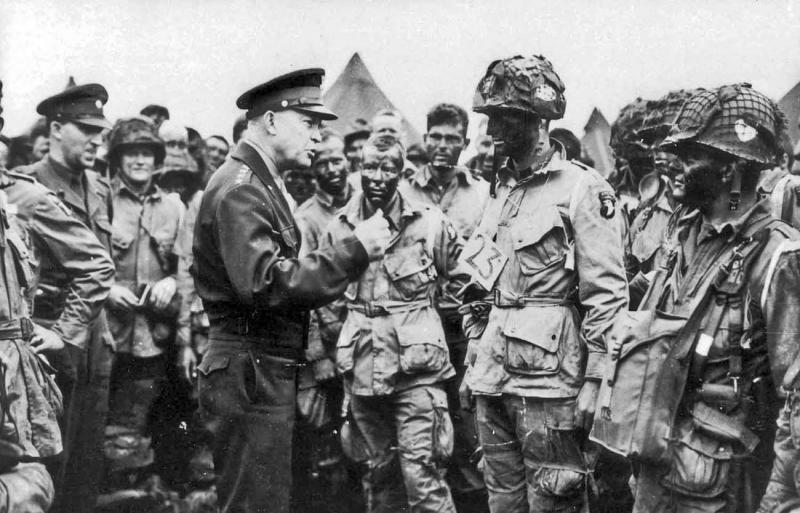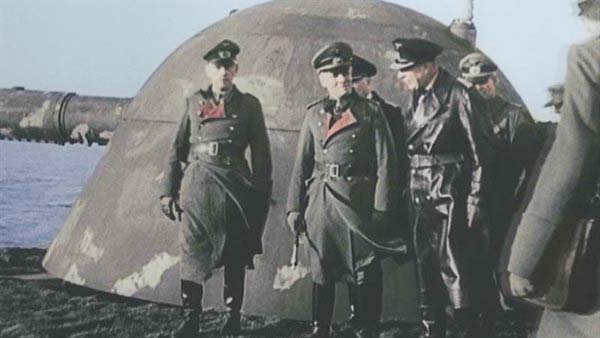D-Day Sacrifice, National Geographic | reviews, news & interviews
D-Day Sacrifice, National Geographic
D-Day Sacrifice, National Geographic
Classic archive footage portrays the Normandy invasion, with added colour

With the 70th anniversary of D-Day following hard on the heels of the extensive World War One commemorations, battle fatigue is becoming a very real concern for TV-watchers.
Although this was a multinational collaborative effort, the premise was straightforward. The two one-hour films told the invasion story via news footage shot before, during and after the landings, most of it of astoundingly high quality, and it had been digitally converted from the original black and white into colour. Even in the wake of a movie like Saving Private Ryan, which brought home the terror and chaos of the battlefield with hideous intensity, this real-life archive material delivered galvanising shocks of its own (below, German commander Erwin Rommel inspects the Normandy defences). Robert Capa's startling still photos from Omaha Beach lent an additional frisson of actualité.
 The tale of the elaborate planning for the Normandy invasion, with its massing of forces in southern England and cunning ruses to convince the Germans that the real target was the Pas-de-Calais, has been told often enough, but scenes of paratroopers blackening their faces with boot polish before roaring off to be dropped in darkness behind the German front lines before the invasion began made real the near-suicidal nature of the exercise. Over footage of American troops clambering into landing craft in unpleasantly choppy seas off the Normandy coast, we heard the words of GI Samuel Fuller (the future movie director), wondering if posterity would record the way the decks of the boats were covered in so much vomit it was like walking on an ice-rink. We heard Fuller's words again as the troops struggled off their boats towards the beach - "I swallow a ton of water, mixed with American blood."
The tale of the elaborate planning for the Normandy invasion, with its massing of forces in southern England and cunning ruses to convince the Germans that the real target was the Pas-de-Calais, has been told often enough, but scenes of paratroopers blackening their faces with boot polish before roaring off to be dropped in darkness behind the German front lines before the invasion began made real the near-suicidal nature of the exercise. Over footage of American troops clambering into landing craft in unpleasantly choppy seas off the Normandy coast, we heard the words of GI Samuel Fuller (the future movie director), wondering if posterity would record the way the decks of the boats were covered in so much vomit it was like walking on an ice-rink. We heard Fuller's words again as the troops struggled off their boats towards the beach - "I swallow a ton of water, mixed with American blood."
If some scenes looked superficially familiar from previous WW2 documentaries, it was if they'd just been black and white trailers for the real thing assembled here. There was a lengthy scene of Canadians landing at Bernières-sur-Mer, and you felt like you were jostling elbow to elbow with them and sharing their ghastly sensation of helplessness as the German gunners opened fire. In footage of Americans trapped at the base of the cliffs on Omaha Beach, the shock and exhaustion on their faces made words unnecessary. A glimpse of human entrails slopping around inside a landing craft was merely unspeakable.
 There was some remarkable material from the German side too. We saw SS tank regiments carrying grinning teenagers from the Hitler Youth towards the beaches to try to fight off the invaders, and the camera looked straight down the barrel of German guns firing at Allied fighter-bombers as they thundered low overhead (wrecked German tank, above).
There was some remarkable material from the German side too. We saw SS tank regiments carrying grinning teenagers from the Hitler Youth towards the beaches to try to fight off the invaders, and the camera looked straight down the barrel of German guns firing at Allied fighter-bombers as they thundered low overhead (wrecked German tank, above).
But it wasn't all shooting and explosions. There were voice-over accounts from French civilians who watched it all happen with a mixture of terror and euphoria, while the diaries of Kay Summersby, General Eisenhower's chauffeur, gave a cool and analytical insider's perspective (although the bit where she described an intimate encounter with the Supreme Commander raised the temperature somewhat). There was a glimpse into the future shape of post-war Europe too, as the climactic account of the liberation of Paris ended with General de Gaulle marching towards Notre Dame cathedral, rubber-stamping himself as the triumphant embodiment of liberated France. D-Day Sacrifice trenchantly evoked just what momentous days these were.
The future of Arts Journalism
You can stop theartsdesk.com closing!
We urgently need financing to survive. Our fundraising drive has thus far raised £33,000 but we need to reach £100,000 or we will be forced to close. Please contribute here: https://gofund.me/c3f6033d
And if you can forward this information to anyone who might assist, we’d be grateful.

Subscribe to theartsdesk.com
Thank you for continuing to read our work on theartsdesk.com. For unlimited access to every article in its entirety, including our archive of more than 15,000 pieces, we're asking for £5 per month or £40 per year. We feel it's a very good deal, and hope you do too.
To take a subscription now simply click here.
And if you're looking for that extra gift for a friend or family member, why not treat them to a theartsdesk.com gift subscription?
more TV
 MobLand, Paramount+ review - more guns, goons and gangsters from Guy Ritchie
High-powered cast impersonates the larcenous Harrigan dynasty
MobLand, Paramount+ review - more guns, goons and gangsters from Guy Ritchie
High-powered cast impersonates the larcenous Harrigan dynasty
 This City is Ours, BBC One review - civil war rocks family cocaine racket
Terrific cast powers Stephen Butchard's Liverpool drug-ring saga
This City is Ours, BBC One review - civil war rocks family cocaine racket
Terrific cast powers Stephen Butchard's Liverpool drug-ring saga
 The Potato Lab, Netflix review - a K-drama with heart and wit
Love among Korean potato-researchers is surprisingly funny and ideal for Janeites
The Potato Lab, Netflix review - a K-drama with heart and wit
Love among Korean potato-researchers is surprisingly funny and ideal for Janeites
 Adolescence, Netflix review - Stephen Graham battles the phantom menace of the internet
How antisocial networks lead to real-life tragedy
Adolescence, Netflix review - Stephen Graham battles the phantom menace of the internet
How antisocial networks lead to real-life tragedy
 Drive to Survive, Season 7, Netflix review - speed, scandal and skulduggery in the pitlane
The F1 documentary series is back on the pace
Drive to Survive, Season 7, Netflix review - speed, scandal and skulduggery in the pitlane
The F1 documentary series is back on the pace
 A Cruel Love: The Ruth Ellis Story, ITV1 review - powerful dramatisation of the 1955 case that shocked the public
Lucy Boynton excels as the last woman to be executed in Britain
A Cruel Love: The Ruth Ellis Story, ITV1 review - powerful dramatisation of the 1955 case that shocked the public
Lucy Boynton excels as the last woman to be executed in Britain
 Towards Zero, BBC One review - more entertaining parlour game than crime thriller
The latest Agatha Christie adaptation is well cast and lavishly done but a tad too sedate
Towards Zero, BBC One review - more entertaining parlour game than crime thriller
The latest Agatha Christie adaptation is well cast and lavishly done but a tad too sedate
 Bergerac, U&Drama review - the Jersey 'tec is born again after 34 years
Damien Molony boldly follows in the hallowed footsteps of John Nettles
Bergerac, U&Drama review - the Jersey 'tec is born again after 34 years
Damien Molony boldly follows in the hallowed footsteps of John Nettles
 A Thousand Blows, Disney+ review - Peaky Blinders comes to Ripper Street?
The prolific Steven Knight takes us back to a squalid Victorian London
A Thousand Blows, Disney+ review - Peaky Blinders comes to Ripper Street?
The prolific Steven Knight takes us back to a squalid Victorian London
 Zero Day, Netflix review - can ex-President Robert De Niro save the Land of the Free?
Panic and paranoia run amok as cyber-hackers wreak havoc
Zero Day, Netflix review - can ex-President Robert De Niro save the Land of the Free?
Panic and paranoia run amok as cyber-hackers wreak havoc
 The White Lotus, Series 3, Sky Atlantic review - hit formula with few surprises but a new bewitching soundtrack
Thailand hosts the latest bout of Mike White's satirical takedown of the rich and privileged
The White Lotus, Series 3, Sky Atlantic review - hit formula with few surprises but a new bewitching soundtrack
Thailand hosts the latest bout of Mike White's satirical takedown of the rich and privileged
 Hacks, Season 3, NOW review - acerbic showbiz comedy keeps up the good work
Jean Smart's portrayal of Deborah Vance is an all-time classic
Hacks, Season 3, NOW review - acerbic showbiz comedy keeps up the good work
Jean Smart's portrayal of Deborah Vance is an all-time classic

Add comment